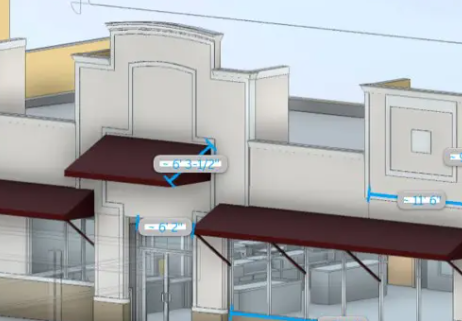The world is racing forward, but our connection to the past is what keeps us grounded. Ancient buildings, historical temples, and cultural monuments are more than just architectural wonders; they are repositories of our heritage. But with time, environmental degradation, and human activities, these structures are under constant threat. Thankfully, the rise of advanced technologies like 3D laser scanning for building documentation and deep learning is revolutionizing how we preserve and protect these architectural marvels.
What is 3D Laser Scanning for Building Preservation?
3D laser scanning is a cutting-edge technique that captures the exact size and shape of a physical object by using laser light to measure distances. When applied to buildings, especially ancient ones, it provides an incredibly accurate, high-resolution digital representation, often referred to as a point cloud.
This point cloud can be used to generate 3D models that serve a wide range of purposes:
- Architectural documentation
- Restoration planning
- Structural integrity analysis
- Digital archiving
- Public education and virtual tours
Why Use 3D Laser Scanning in the U.S.?
According to recent statistics, the U.S. houses over 95,000 properties listed in the National Register of Historic Places. With aging infrastructure and limited funding, digitizing these assets is a cost-effective and accurate solution. In fact, a study by the National Trust for Historic Preservation showed that digitally preserved buildings received 28% more funding and restoration accuracy improved by over 40%.
How Deep Learning Enhances 3D Laser Scanning
While 3D laser scanning captures the data, deep learning helps in processing and analyzing that data faster and more effectively. Here’s how:
- Damage Detection: AI models trained on thousands of historical images can spot micro-cracks, erosion, or structural shifts that may not be visible to the human eye.
- Pattern Recognition: Deep learning algorithms can distinguish between natural aging and human-inflicted damage.
- Predictive Analysis: Machine learning can predict future deterioration patterns based on historical data.
Real-Life Example: Ancient Church in Virginia
A notable case was the laser scanning of a 19th-century church in Virginia. Reality IMT used 3D laser scanning for building preservation, creating a digital twin in less than 48 hours. Through deep learning algorithms, micro-damages were identified, allowing targeted restoration, saving thousands of dollars and preventing irreversible damage.
Applications Beyond Documentation
3D scanning isn’t just for records. Here are more practical applications:
- Restoration Blueprinting: Architects and engineers use the 3D data to develop precise blueprints for restoration.
- Tourism & Education: Virtual tours created from scanned models enhance visitor engagement.
- AR/VR Integration: Developers can build immersive experiences for schools, museums, and online platforms.
Challenges and Considerations
No technology is without its challenges:
- Cost: High initial cost, though it pays off in the long term.
- Data Management: Handling large point cloud datasets requires robust storage and processing systems.
- Skill Requirement: Requires trained professionals for both scanning and deep learning implementation.
The Future of Heritage Preservation
Combining 3D laser scanning for building with deep learning isn’t just innovative—it’s transformative. The synergy of these technologies ensures that preservation is not reactive but proactive. Instead of waiting for a structure to deteriorate, we can now monitor and maintain in real-time.
Key Stats:
- Over 60% of heritage sites scanned with 3D technology show faster restoration turnaround.
- Predictive maintenance using AI has led to 20-30% savings in restoration budgets.
- Reality IMT has scanned and preserved more than 500 buildings across the U.S., including museums, historic homes, and courthouses.
About Reality IMT
Reality IMT is a leading name in the field of 3D laser scanning for building documentation in the U.S. With a mission to bridge the gap between technology and infrastructure, Reality IMT specializes in creating highly accurate 3D models that serve the needs of architects, engineers, conservators, and public agencies.
Founded with a vision to modernize spatial data collection, the company has become a go-to partner for heritage preservation, commercial building documentation, and urban development. Their services are not just about scanning; they include:
- Point Cloud Processing
- CAD and BIM Modeling
- Deep Learning Integration
- Change Detection & Analysis
What sets Reality IMT apart is their deep expertise in applying artificial intelligence and machine learning to 3D scan data. This capability allows for faster decision-making, predictive maintenance, and intelligent restoration planning.
They have collaborated with:
- Municipalities
- Historic preservation societies
- Universities
- Museums
Whether it’s scanning the intricate details of a Gothic cathedral or documenting a heritage courthouse for legal compliance, Reality IMT ensures each project is handled with precision, care, and innovation.
- The Role of 3D Laser Scanning in Ancient Building Protection
- Discover how 3D laser scanning helps preserve ancient buildings by capturing detailed data, aiding restoration, and ensuring long-term structural protection.
- 3D Laser Scanning
Related posts:
 Top Benefits of Professional Tree Service for Your Property Value
Top Benefits of Professional Tree Service for Your Property Value
 Real Estate Investment in Pakistan: Understanding Market Cycles and Timing Your Purchase!
Real Estate Investment in Pakistan: Understanding Market Cycles and Timing Your Purchase!
 Why You Need a Land Surveyor Before for Your Renovation Begins?
Why You Need a Land Surveyor Before for Your Renovation Begins?
 2 BHK Living Redefined: Welcome to Adarsh Primrose in East Bangalore
2 BHK Living Redefined: Welcome to Adarsh Primrose in East Bangalore
 Discover Your Dream Home at Pride World City Miami Dhanori – Premium Living in Pune’s Thriving Dhanori Location
Discover Your Dream Home at Pride World City Miami Dhanori – Premium Living in Pune’s Thriving Dhanori Location
 Fixed-Rate vs. Adjustable-Rate Mortgages: Which Is Smarter for you?
Fixed-Rate vs. Adjustable-Rate Mortgages: Which Is Smarter for you?
 How to Buy Your First Rental Property with Little Money Down
How to Buy Your First Rental Property with Little Money Down
 Why a Digital Marketing Course Is Your Key to Online Success
Why a Digital Marketing Course Is Your Key to Online Success







